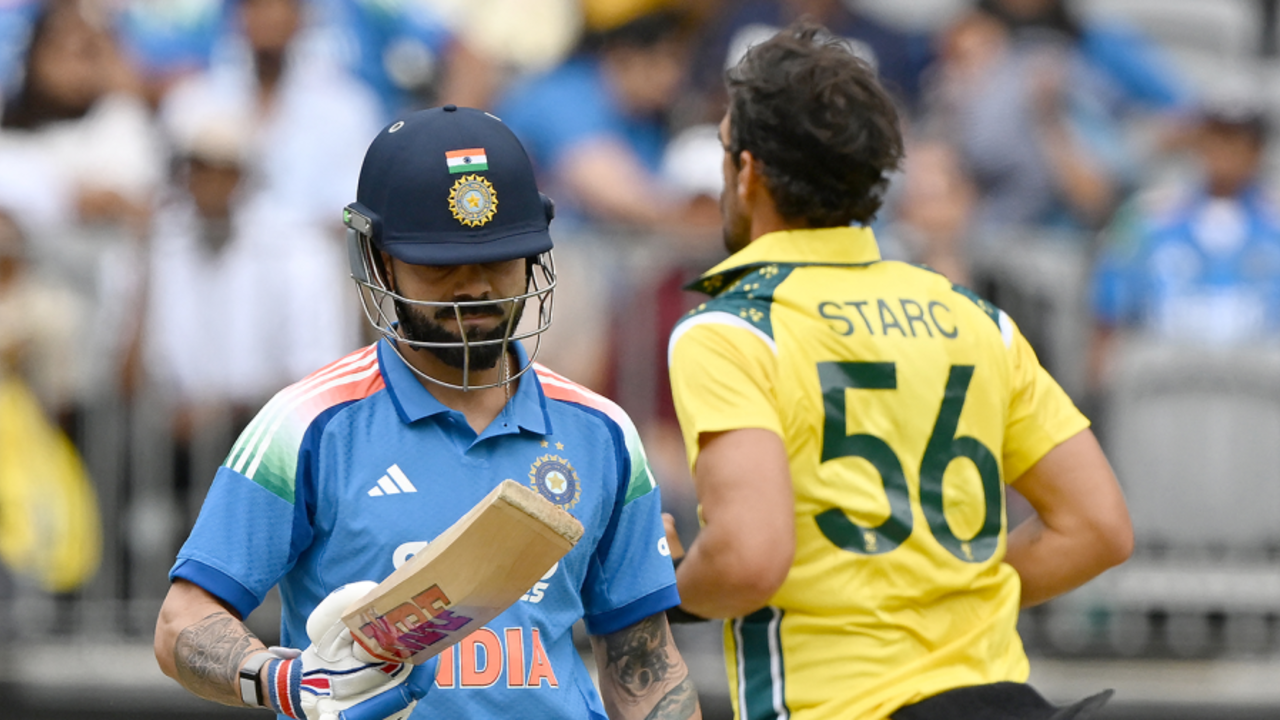India's ODI gameplan tested in pacy Perth
Their tactics of stacking the batting at the expense of attacking bowlers will be tested in Australia more than it was during the Champions Trophy
Sidharth Monga
19-Oct-2025
Mitchell Starc dismissed Virat Kohli for a duck in Perth • AFP/Getty Images
Perth posed an extreme change in conditions to a team that was due a test of conditions. In their previous ODI assignment, the Champions Trophy in February and March, India were unbeaten in the tournament despite not winning a single toss. So dominant were they on those pitches in Dubai that they played just one specialist fast bowler and two specialist spinners in Kuldeep Yadav and Varun Chakravarthy.
They were always going to be tested when conditions - as those in most ICC tournaments - demanded a more balanced XI. Conditions offering pace and bounce where India's spin-bowling allrounders are diminished both as batters and bowlers.
The big question in these - let's say standard - conditions is how India would stay threatening with the ball in the middle overs of an ODI. They had taken so many wickets in the middle overs during the Champions Trophy that the contests were over before they could be tested at the death.
In Australia, the death overs were also going to be a challenge in the absence of Jasprit Bumrah, who was rested after playing back-to-back Tests against West Indies. The premium of Rohit Sharma's aggressive starts also reduces, though perhaps to a lesser extent, in these conditions.
India's defeat in the rain-hit series opener in Perth, though, gives us little to glean on these fronts. They lost their 16th consecutive toss in ODIs, were inserted in early-summer Australian conditions that veered to the other extreme from those in Dubai, and then two batters gloved balls down the leg side just before rain breaks, which adversely affected their DLS adjustments.
India's fast bowlers extracted movement, asked some questions, but overall they didn't have enough to defend. In such chases, opposition batters can play positively without hesitation. Any small error is punished, and there were small errors made on the line. Travis Head won't cut a wide ball straight to deep point every day.
Any team can lose comprehensively on a day like this. It will be harsh to say more than that. However, the gauntlet has been thrown. India will be out of their comfort zone for the rest of the series. They will be tested both on their selections and the adjustments they make on the fly.
It is difficult to judge Rohit and Virat Kohli on such short knocks - dismissed for 8 and 0 respectively - in their first ODI in seven months, and unfair to put them on trial every match, but there is no better time for them to show the value of their experience.
On team selection, Shubman Gill left himself few attacking options in the middle overs by leaving out Kuldeep. While this combination offers batting depth by having Harshit Rana at No. 9, it means India have to bowl 20 overs of fingerspin and part-time pace in Australian conditions. That is if the three quicks can bowl 30 overs.
In an ideal world, India would like conditions where two frontline quicks and a seam-bowling allrounder are sufficient, leaving them one slot for a wristspinner or a mystery spinner. They might get such conditions at the 2027 World Cup, but that tournament will also be played in early-summer conditions in South Africa, Zimbabwe and Namibia.
If they continue to face conditions like in Perth, India might be forced to play three frontline fast bowlers in Adelaide and Sydney, which is where their insistence on batting depth at the cost of wicket-taking ability in the middle overs will be tested.
Sidharth Monga is a senior writer at ESPNcricinfo

